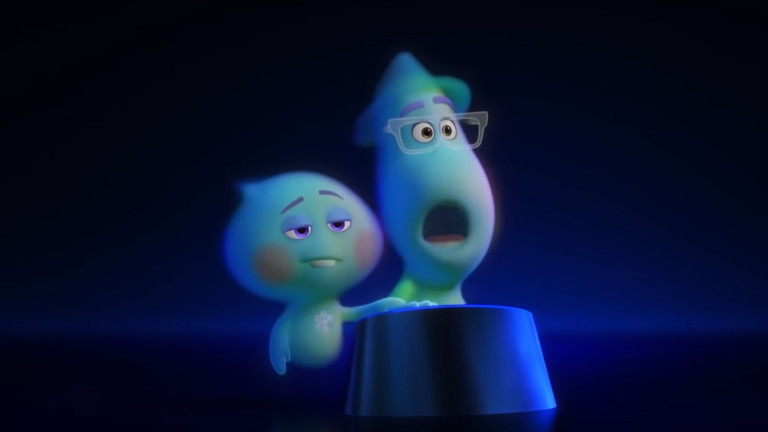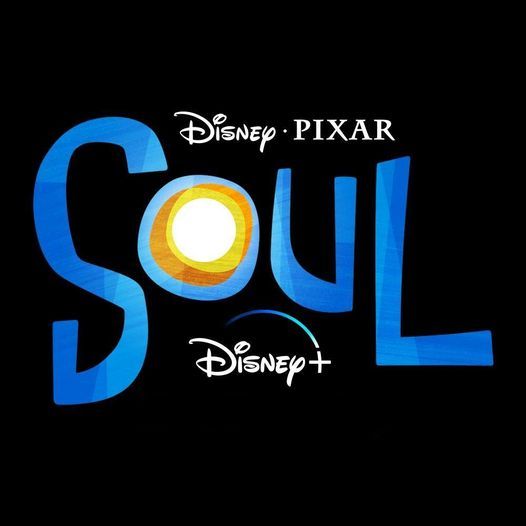The afterlife — and even the “before life!” — play a crucial role in Pixar’s latest release, “Soul.” But unlike the traditional Heaven & Hell paradigm of Judeo-Christian / Western tradition, “Soul’s” hereafter is a gauzy mish-mash of religious concepts and abstractions.
The film is marketed as a kid’s movie, but the topics it broaches are rather “adult.” The story revolves around Joe, a middle school music teacher who dreams of becoming a jazz pianist. He gets his big break when he’s invited to join a popular quartet led by saxophonist Dorothea Williams. But just before his first performance, tragedy strikes leaving Joe’s body in a coma. His spirit, however, awakes in Pixar limbo. Or some conceptual equivalent.
Actually, Joe finds himself first in the “Great Beyond,” and then (because of an accounting error) in the “Great Before,” where souls are being prepared for Earth. There, he encounters archetypal guides, beings comprised of universal quantum fields, and ethereal, milky “souls,” both coming and going. It’s made clear, early on, that this is not “hell.” The closest counterpart would be the “lost souls” who wander in the Astral Plane. The Astral Plane is adjacent to the “You Seminar,” which exists in the Great Before. The “You Seminar” assists unborn souls in developing different traits, quirks and personalities. There, these pre-born souls can participate in various programs where they unlock certain badges and learn about themselves, even taking on mentors like Mother Theresa, Gandhi, or Carl Jung.
Still following?

Anyway, Joe is unwilling to enter the Great Beyond. (What exactly awaits there, isn’t revealed.) Having left earth at the brink of his “big break,” he refuses to “move on.” Joe is eventually assigned to mentor a troubled soul called 22 who’s resisted birth for centuries. Their relationship forms the basis for valuable insights into life. At least, as they travel between Earth and… the Other Place.
So what are Christian viewers, parents, and creatives to think of the Afterlife as framed in Pixar’s “Soul”?
Let me make clear, from the outset, that this is not intended as a review of the movie. I’m simply interested in the spiritual elements and religious themes portrayed in the film. (But, for the record, I mostly enjoyed the movie. Yeah, the thematic pay-off is disappointing. However, the animation is fantastic, the music is also good, and there’s some funny, witty parts.)
When judging stories, I think it’s important to distinguish a fictional framework from hard theology. You can’t expect a movie to articulate doctrine. It’s necessary to step back and look at the bigger picture of what the film is trying to say, without sifting every character or element through a fine-toothed theological comb.
Interestingly enough, Pete Docter, the film’s director, has called himself a Christian. In this interview with Radix magazine, one of the reasons Docter hedges on ever making a “Christian movie” is messaging.
Radix: Do you ever see yourself making a more explicitly Christian movie?
Docter: Not at this point. I don’t know that that’s really me. I don’t feel so comfortable with that. Even if you have a moral to a story, if you actually come out and say it, it loses its power. Not that we’re trying to be sneaky or anything, but you have more ability to affect people if you’re not quite so blatant about it. Does that make sense?
Radix: That seems right in line with what Jesus’ parables were too. He tended not to come right out and explain, “This is what I was trying to say.”
Docter: To me art is about expressing something that can’t be said in literal terms. You can say it in words, but it’s always just beyond the reach of actual words, and you’re doing whatever you can to communicate a sense of something that is beyond you.
Knowing this, it’s important to give Docter and his creative team the benefit of the doubt. Is there a “moral” or message that Soul’s picture of the afterlife is intended to convey? Well, as a fictional springboard, Soul’s afterlife could simply be a mechanism to transition characters between temporal existence and metaphysical realities. However, it’s there that the problems arise.
How the afterlife is portrayed is a “message” in and of itself. Especially in a kid’s movie! So what messages does Soul send to our children about the afterlife?
Clearly, one of the messages of Soul is religious syncretism, a synthesis of all religions and beliefs.
Discussing how the filmmakers “captured the essence of the afterlife,” Wired magazine highlights the broad range of religious concepts and peoples that the filmmakers sought to incorporate.
“In making Soul… Pixar’s animators had to find common ground between dozens of different belief systems to create a one size fits all version of what happens to us after we die, but also before we’re born.
“‘We wanted it to be very non-specific in terms of culture,’ says Pete Docter, who co-directed the film alongside Kemp Powers. ‘If you look at it and go, ‘That’s Greek, or Italian, or Chinese’ that would be wrong because souls, we are saying in the film, come to Earth kind of as a blank slate. Your culture is something that you learn and grow into.” To help, the filmmakers brought in religious experts, personality experts, and even shamans, says producer Dana Murray.”
It’s easy to sympathize with Docter’s desire “to find common ground between dozens of different belief systems.” The problem is, such attempts logically lead to a kind of pluralistic gibberish in which nothing is universally true, all messiahs are legit, and everyone goes to heaven. Or becomes a god. Or merges with the Universe. Or whatever!
As a result, Soul’s afterlife is populated with numerous dissonant religious concepts.
For example, one religion writer notes how Hollywood Loves the Mormon Afterlife.
“…Soul has a full-blown narrative about the premortal path of human beings. The ‘pre-existence’ as conceived in Soul is not identical to what Latter-day Saints believe—there’s no war in heaven, and most fundamentally, no creator God. But it’s close in other details, like the idea that disembodied intelligences have core aspects of their eventual human personality and life spark already attached.
“And most crucially, it’s rooted in the same core belief: that everyone who is walking on this earth does so because he or she made an active choice to come here.”
Christians have traditionally viewed Mormonism as a false religion. The belief in pre-existent souls who choose to be born is just one of many doctrinal differences.
In his review at the Catholic News Service, John Mulderig sees the default religion of Soul as “New Age”:
Although it’s understandable that the filmmakers feel bound to portray the spiritual arena in a nondenominal way in order to avoid offending religious sensibilities, the result feels sterile. In place of angels, for instance, we get cubist-style figures who identify themselves as — more or less — the sum of all the laws of physics.
To the extent that any belief system is represented, the unfortunate choice falls on the New Age movement. Thus, during a sojourn in yet another nonphysical region, the Astral Plane, Joe receives guidance from a middle-aged hippie called Moonwind (voice of Graham Norton) and from the various shamans by whom he’s surrounded.
Another reviewer described the film as “a veritable hodgepodge of ideas that are unbiblical and contradictory.” Elements of reincarnation, Buddhism, animism, and mysticism all make brief appearances. For example, during one scene Joe is told he can reconnect with his physical body through the “crown chakra… the seventh primary chakra in Tibetan Buddhism.”
In Disney/Pixar’s ‘Soul’: A Midlife-Crisis Story Wrapped in Gauzy Metaphysics, Kate O’Hare also notes the syncretistic, New Age components of the film:
The metaphysics of Soul aim for hazy and indistinct but instead wind up leaning in the direction of New Age and Eastern mysticism, including references to the Universe, meditation and chakras. There is no mention of God or any particular Higher Power
She concludes, “Soul tries so hard to be vague and not offend anybody’s belief system (despite borrowing bits of belief systems) that it loses a valuable opportunity to really blow your mind. It’s nice enough and positive enough, but it’s just not enough enough.”
As I said above, I’ll give Docter the benefit of the doubt and assume that he is trying to convey something about the afterlife to stir and evoke hope in his audience. In fact, in the simplest sense, even portraying a possible afterlife is a good thing. In our secular, materialistic age, the belief that souls live on is, at least, a step in the right direction. Sure, themes of “second chances” and “living life to its fullest” are well-worn, if not banal. But considering some of the other elements Docter chose to use along the way, I can’t help but see his spiritual message as muddled.
Jazz music, like all music, adheres to certain norms. F minor is F minor the world over. But while the music of Soul hits all the right notes, its metaphysics are more like white noise.
Mulderig correctly concludes,
“If youngsters are anxious to watch the movie, parents could make it the springboard for a family discussion about life after death and related matters. But they should be aware going in that there’s a lot on screen that needs to be sorted through with discernment and care.”















